Soo Line Building
1915, 1960, 2011
PDF of the Soo Line Building History
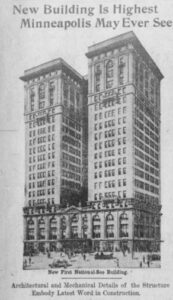
When the First National Bank-Soo Line Building was completed in 1915, it was the tallest building in Minneapolis. The Minneapolis Sunday Tribune stated on March 28, 1915, “In addition to its height of 20 stories which can never be duplicated under present building laws, the building has excellencies of an architectural and mechanical nature which mark it as the last word in modern office building methods”. The First National Bank-Soo Line Building held the distinction of being the tallest building in Minneapolis for 14 years until the Foshay Tower was built in 1929.
The building represented a collaboration between First National Bank of Minneapolis and the Minneapolis, St. Paul and Sault Ste. Marie Railroad. The building was meant to be occupied as corporate headquarters for both entities.
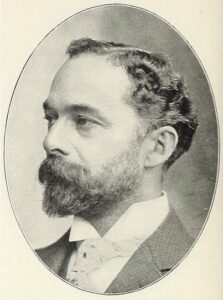 While under construction in 1914, a load of girders raised to the top of the building gave way and killed two men and a team of horses. As a result of the accident, orders were given that “the hoisting of any material by crane or derrick is prohibited unless all traffic, pedestrians, teams, autos, street cars or any other vehicle is stopped between the middle and south side of Fifth Street”.
While under construction in 1914, a load of girders raised to the top of the building gave way and killed two men and a team of horses. As a result of the accident, orders were given that “the hoisting of any material by crane or derrick is prohibited unless all traffic, pedestrians, teams, autos, street cars or any other vehicle is stopped between the middle and south side of Fifth Street”.
Later in 1914, it was announced that the entire fourth floor of the building, still under construction, would be used for a permanent building trade exhibit, for the convenience and business advancement of architects, general contractors, and builders. The trade exhibit was touted as the largest in the Northwest. The Minneapolis Tribune reported on November 9th, 1914, “It is expected that many manufacturers from all parts of the country will make this place their headquarters for the entire Northwest.”
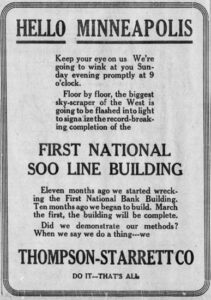
The building, as the Minneapolis Tribune noted is a “justifiable source of pride to Minneapolis”, and took ten months to build. Robert W. Gibson, an English-born American architect, designed the Soo Line Building. He practiced primarily in New York State and is best known for several churches he designed in New York City. Gibson retired shortly after the Soo Line project was completed. Gibson was influenced by the 1893 World Columbian Exposition in Chicago. He used techniques from the Les Ecole des Beaux-Arts to design the Soo Line Building. It is one of few buildings that has details from the Second Renaissance Revival. The bottom three floors are covered in gray granite, with the remaining floors clad in terra cotta. The integrity of the building, erected in 1915, is intact.
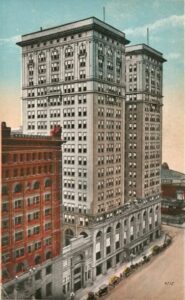
Eleven miles of steam pipe carried heat to more than 800 radiators. Seven carloads of plate glass were used in the windows of the building, the largest contract of its kind ever placed in the Northwest. The largest lock contract ever awarded was given to W. K. Morrison Company. Not only did they install 2000 locks, with 10,000 accompanying keys, but for the first time in history, the locks were fitted into the metal doors and frames. The doors and frames were templated with matching locks at the factory and shipped ready to install.
A notable difference during the construction of the First National Bank-Soo Line Building was the lack of smoke from the hoisting machines. All material raised to the building top was hoisted by electric motors furnished by General Electric Company.
An opening reception was held at the new First National Bank-Soo Line Building on Sunday evening, February 28, 1915. Five thousand people attended a reception on the 17th floor, then made their way two floors up to look down on the city from the building’s top floor. Although admission to the building was intended to be by invitation only, the crowd overtook the building entrance, and everyone who desired entered.
Room 703 in the building was set aside for banking classes, conducted under the auspices of the American Institute of Banking. On October 15, 1916, the Sunday Tribune reported that the bank had opened a dining hall for bank officers and employees. The private dining room was located in the basement of the First National-Soo Line Building. Lunch could be obtained for 25 cents. Fine service was ensured by retaining the services of Mrs. Edith M. Jones, who had complete charge of the dining room and kitchen.
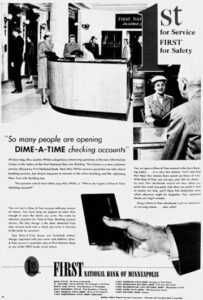
In the late 1950s, plans were underway for a new First National Bank building. Considerations to renovate the existing building were scrapped. Instead, plans were made to vacate the bank facilities at the First National Bank-Soo Line Building and build a new facility that would integrate all the downtown First National Bank offices. With the bank’s departure, the building was updated for small office tenants. The marble floors were covered with carpet. The bottom three floors of the building were “modernized” with aluminum-framed windows on the exterior covering original glass panes. Brass teller cages and railings, mahogany desks and chairs, curlicue light fixtures, and the guard’s turret were all removed. A first-floor decorative staircase was covered over. The concrete vault was removed with jackhammers. White marble was stripped from the walls and columns. With renovations completed, new tenants included the Great Northern Insurance Company, a stock brokerage firm, a cigar store, and a jeweler.
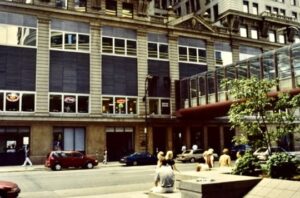
The Soo Line Building was placed on the National Register of Historic Places in 2008. In 2011, the building was purchased by the developer Village Green Properties and the conversion to apartment living began. Today, the building houses 254 luxury apartments and both street-level and skyway commercial spaces. 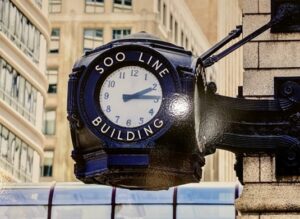 The building has a rooftop outdoor space, as well as an indoor pool. The iconic clock was added to the corner of the building within a few years of the building’s opening. It exists today as a landmark in downtown Minneapolis.
The building has a rooftop outdoor space, as well as an indoor pool. The iconic clock was added to the corner of the building within a few years of the building’s opening. It exists today as a landmark in downtown Minneapolis.
